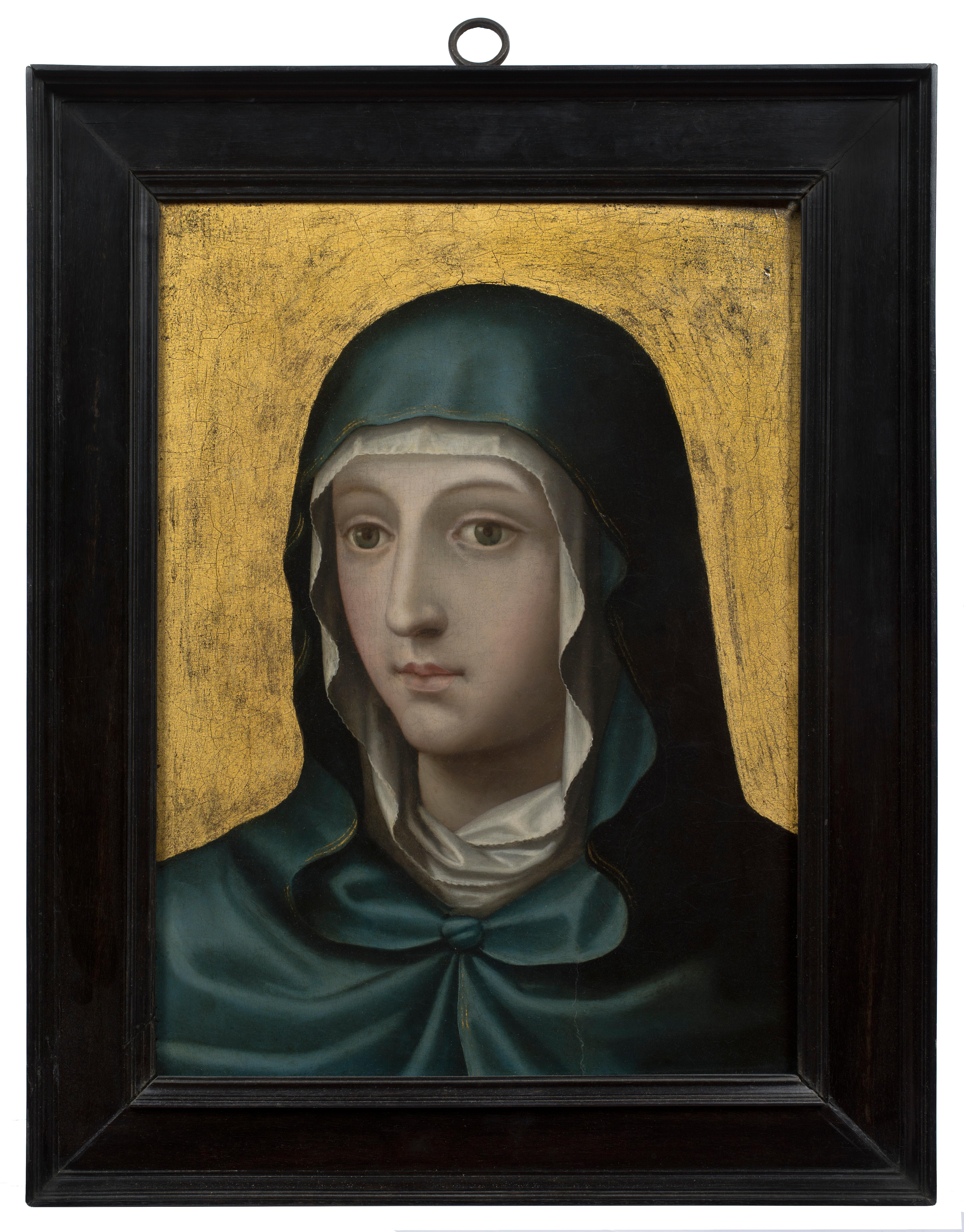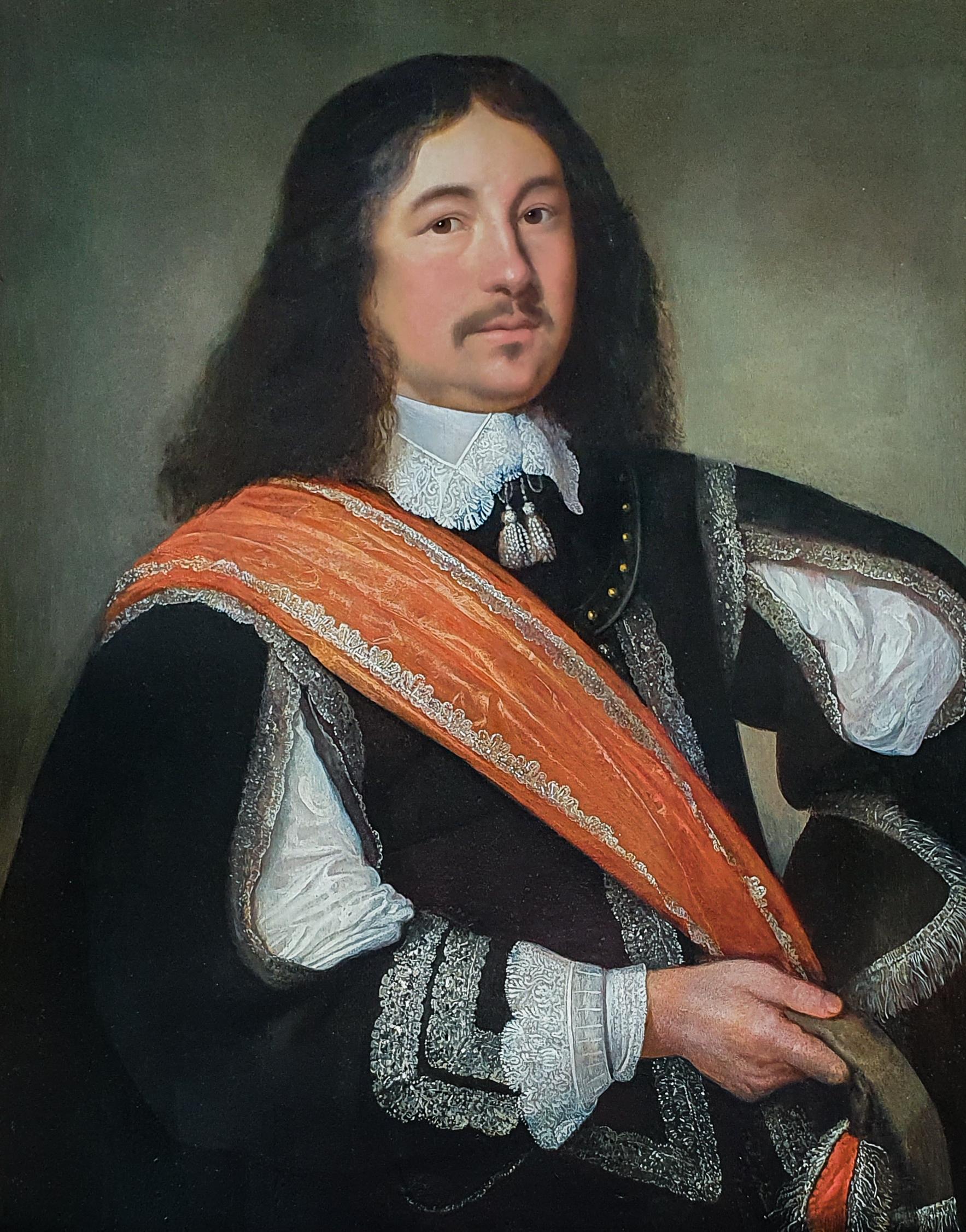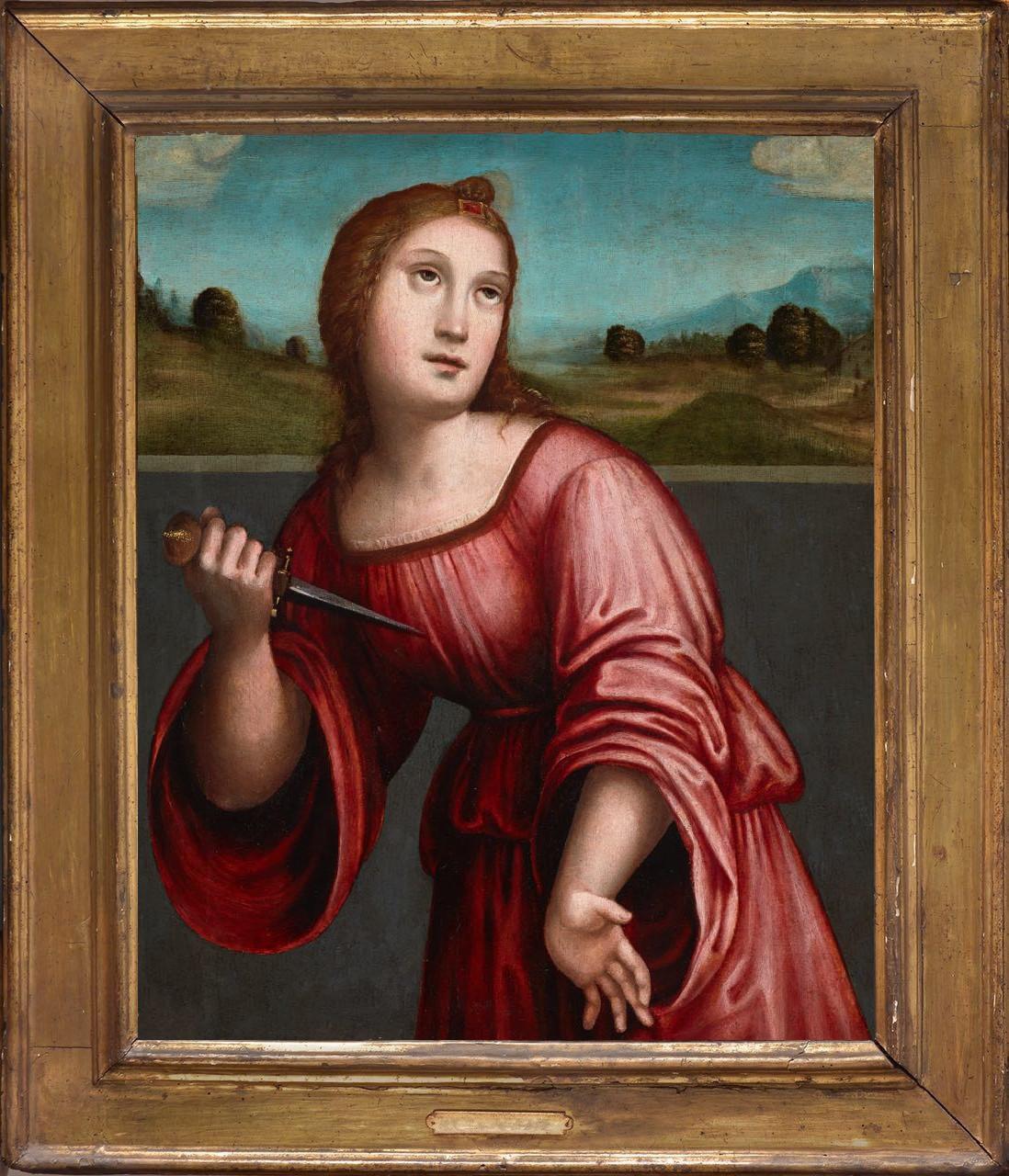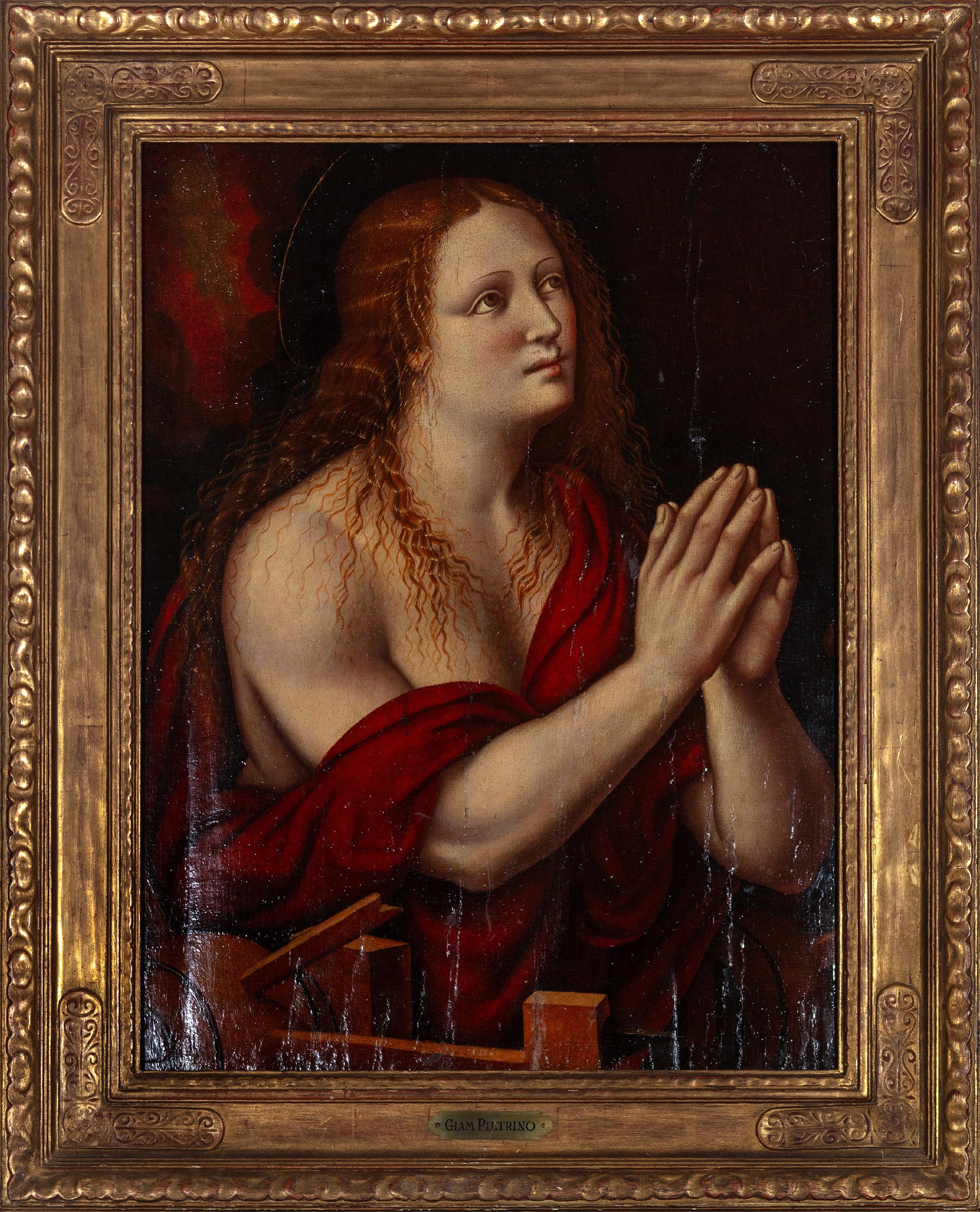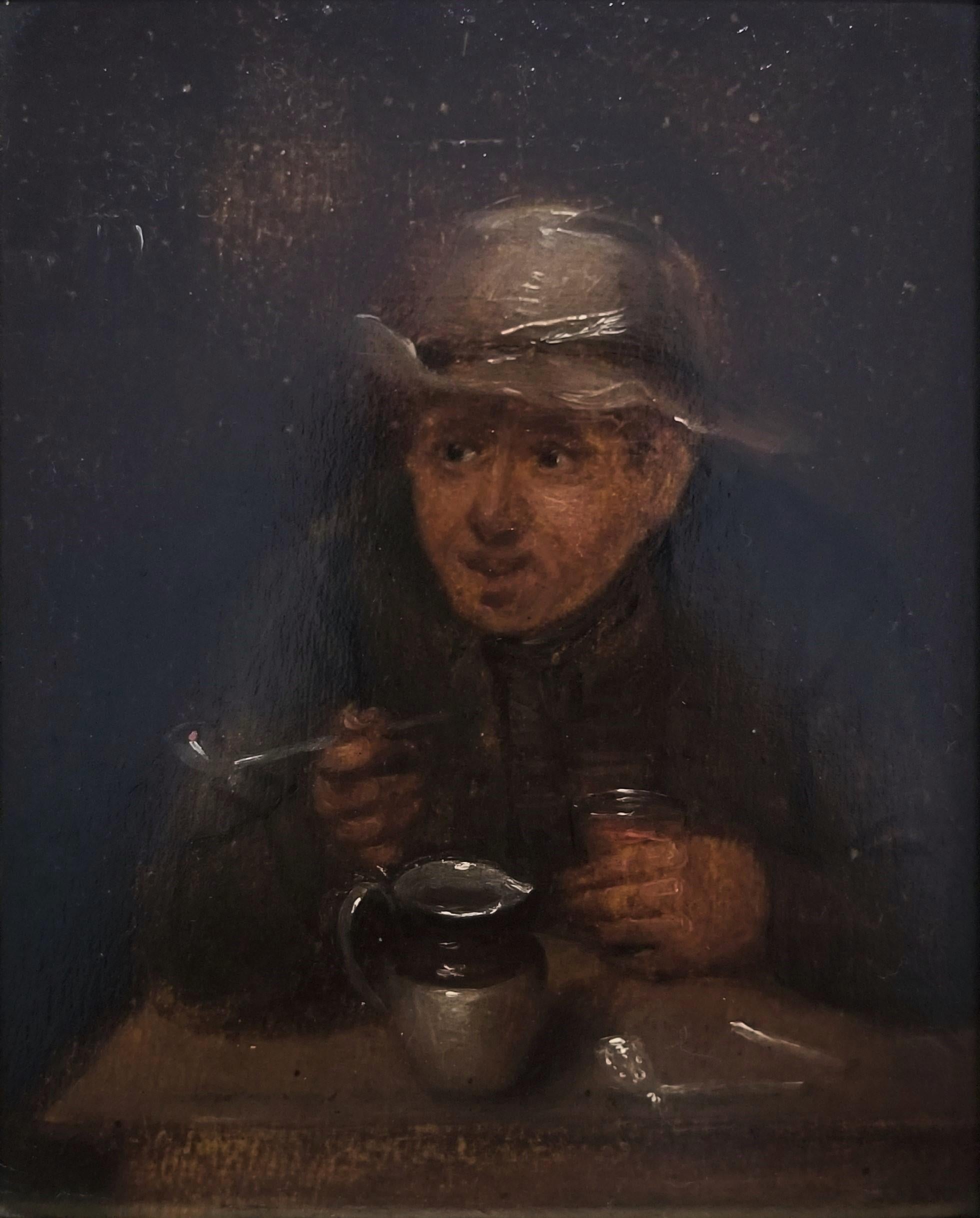Items Similar to Michiel Jansz. Van Mierevelt (Follower), Portrait of Maurice of Orange
Want more images or videos?
Request additional images or videos from the seller
1 of 13
Michiel Jansz. Van Mierevelt (Follower), Portrait of Maurice of Orangec. 1640
c. 1640
About the Item
This early to mid-17th-century oil on panel depicts Maurice of Nassau (1567-1625), Prince of Orange. It’s a bust-length portrait, presented in a feigned oval, after a full length by Dutch artist Michiel Jansz. van Mierevelt (1567-1641).
Maurice of Nassau was a highly proficient military strategist and commanded the Dutch forces during a rebellion against Spain. His genius was borne from an acute understanding of military history, tactics, and mathematics. He was also fascinated by emerging technologies. Here, in this portrait from around 1640, he’s shown wearing a lace ruff, parcel-gilt armour, and a red sash embroidered with gold - as per the original version. The oval is an interesting addition and is reminiscent of compositions used for engravings of the Prince.
Numerous versions of this portrait were produced throughout the 17th century including one by an unknown artist which is currently held in the Royal Collection. There’s another at National Galleries Scotland.
Held within a gilt frame.
Established in 2017, Brave Fine Art is a premier English art dealership based in Cheltenham with clients including national galleries and country estates. Our team includes a conservator, logistics specialist and art historian. Over 1,000 paintings have been transported to the US and Canada safely with hundreds of glowing reviews.
We set our prices fairly from the start as we prefer to sell quickly and continually evolve the collection. Around 40 new discoveries are added every month. If you have any questions at all, we’d love to hear from you.
- Creation Year:c. 1640
- Dimensions:Height: 11.5 in (29.21 cm)Width: 10 in (25.4 cm)
- Medium:
- Movement & Style:
- After:Michiel Jansz. Van Mierevelt (1567 - 1641, Dutch)
- Period:Mid-17th Century
- Condition:Artwork presents well. Fine craquelure but the paint is stable. Frame with some light wear.
- Gallery Location:Cheltenham, GB
- Reference Number:1stDibs: LU2328213642772
About the Seller
5.0
Platinum Seller
These expertly vetted sellers are 1stDibs' most experienced sellers and are rated highest by our customers.
Established in 2017
1stDibs seller since 2023
121 sales on 1stDibs
Typical response time: <1 hour
- ShippingRetrieving quote...Ships From: Cheltenham, United Kingdom
- Return PolicyA return for this item may be initiated within 14 days of delivery.
More From This SellerView All
- Julius Friedländer, Portrait Of The Artist’s Mother, Oil PaintingLocated in Cheltenham, GBThis early 19th-century oil painting by Danish artist Julius Friedländer (1810-1861) depicts his mother, Rebecca Friedländer (1777-1858). Friedländer was predominantly a genre paint...Category
1830s Portrait Paintings
MaterialsCanvas, Oil, Wood Panel
- Jelle Troelstra, Portrait Of A Seated Woman, Oil PaintingLocated in Cheltenham, GBThis early 20th-century oil painting by Dutch artist Jelle Troelstra (1891-1979) depicts a seated woman wearing a floral top and dark grey dress. With eyes closed and hands held upo...Category
1910s Post-Impressionist Portrait Paintings
MaterialsCanvas, Oil
- Curt Ruger, Portrait Study Of A Girl, Oil PaintingLocated in Cheltenham, GBThis late 19th-century oil painting by German artist Curt Ruger (1867-1930) depicts a young girl seated. It was completed during his time at the Academy of Fine Arts in Dresden. Gre...Category
1880s Academic Portrait Paintings
MaterialsCanvas, Oil
- César Fernández Ardavín, Portrait Of A Girl Before A MirrorLocated in Cheltenham, GBThis early 20th-century oil painting by Spanish artist César Fernández Ardavín (1883-1974) depicts a cheerful young woman before a mirror. Buoyant and playful, she sits casually on ...Category
1940s Portrait Paintings
MaterialsCanvas, Oil
- Bror Kronstrand, Portrait Of Brita Söderberg, Oil PaintingLocated in Cheltenham, GBThis charming portrait by Bror Kronstrand (1875-1950) depicts Brita Söderberg (nee Browall) wearing a light blue blouse with a white hat, ribbon and flower. She was 20 at the time. ...Category
Early 20th Century Academic Portrait Paintings
MaterialsCanvas, Oil
- Herman Jensen, A Musician, Oil PaintingLocated in Cheltenham, GBThis enchanting early 20th-century oil painting by Danish artist Herman Jensen (1893-1941) depicts a seated woman playing the banjo before a window. Scenes with musicians are most f...Category
1920s Impressionist Portrait Paintings
MaterialsOil, Canvas
You May Also Like
- The Veronica of the Virgin (Verónica de la Virgen)Located in New York, NYThe panel has been attributed both to Joan de Joanes and his son Vicente Macip Comes (Valencia, ca. 1555 – 1623). Provenance: Private Collection, England, by 1886 (according to stencils on the reverse) Private Collection, New Jersey, until 2010 The Veil of Veronica, often called the Sudarium, is one of the most important and well-known relics of Christ. According to legend, Veronica offered Christ her veil as he carried the cross to his crucifixion. He wiped his face with the veil, which left the cloth miraculously imprinted with his image. Depictions of Christ’s face on a veil, or simply images that focused in on Christ’s face, were treasured objects of religious devotion. The popularity of this format also inspired similar images of the face of the Virgin. The iconographic type of the present painting is known as the Veronica of the Virgin, which was especially favored in late medieval and early Renaissance Spain. Distinct from the images of the suffering Christ, the Veronica of the Virgin is based on the legend that Saint Luke painted a portrait of Mary from life. Although scholars have sometimes mistaken them for portraits of Queen Isabella I of Castile (known as Isabel la Católica) or as a depiction of Saint Maria Toribia (known as María de la Cabeza, or, Mary of the Head), paintings like this one were clearly intended as images of the Virgin in the style of Saint Luke’s lost portrait. The Veronica of the Virgin was especially popular in Valencia, and depictions of this subject produced there all stem back to one visual prototype: a Byzantine image in the city’s cathedral (Fig. 1). This early treatment of the Veronica was given to the cathedral in 1437 by Martin the Humane, King of Aragon and Valencia, who promoted religious veneration of the Veronica of the Virgin as part of the celebration of the Immaculate Conception of Mary. This devotion spread throughout Martin’s kingdom and particularly took hold in Valencia, where the Byzantine image resided. The image, which is displayed in a gold reliquary...Category
16th Century Old Masters Paintings
MaterialsOil, Wood Panel
- Portrait Gentleman Black Slashed Doublet & Orange Sash Dutch Oil on Panel c.1650By Bartholomeus van der HelstLocated in London, GBThis exquisite portrait of a gentleman depicted in a sumptuous black doublet edged with silver and slashed sleeves is an excellent example of the type of portrait fashionable in England and the Low Countries during the 17th century. The confident pose, striking orange sash - the colour of the house of Orange Nassau - and the leather gorget imbue the sitter with a sense of masculinity and power. The profusely decorated costume is of the highest quality and de rigueur of an elite class - the artist has carefully cultivated this portrait to emphasise the sitter’s wealth and standing in the society that he belonged to. The casual pose, with one arm resting on a hip, is much less formal than earlier decades, and it speaks of ‘sprezzatura’ – one’s appearance should not appear laborious, but instead, effortless. The oil on cradled panel portrait can be dated to circa 1650 based on the hairstyle and the attire - small falling collar, short doublet (doublets reduced in size to just below the ribcage in the late 1650’s), and the type of slashed sleeves with the sleeve seams left open to reveal the white fabric. The demand for portraits in the Netherlands was great in the 17th century. Bartholemeus van der Helst was considered to be one of the leading portrait painters of the Dutch Golden Age surpassing even Rembrandt as the most sought-after portraitist in Harlaam. The Dutch Golden Age, roughly spanning the 17th century, was a period when Dutch trade, science, military, and art were among the most acclaimed in the world. Dutch explorers charted new territory and settled abroad. Trade by the Dutch East-India Company thrived, and war heroes from the naval battles were decorated and became national heroes. During this time, The Dutch Old Masters began to prevail in the art world, creating a depth of realistic portraits of people and life in the area that has hardly been surpassed. The Golden Age painters depicted the scenes that their discerning new middle-class patrons wanted to see. This new wealth from merchant activities and exploration combined with a lack of church patronage, shifted art subjects away from biblical genres. Still life’s of items of everyday objects, landscapes, and seascapes reflecting the naval and trade power that the Republic enjoyed were popular. The new wealthy class were keen to have their portraits commissioned and many artists worked in this lucrative field. Such was the popularity of art that everyone had a painting, even the humble butcher, and hundreds of thousands of paintings were produced. By tradition the sitter is Maarten Tromp (1598-1653) who was an Admiral in the Dutch Navy (the reverse of the portrait contains an old handwritten inscription “van Tromp”). Certainly, the distinctive orange sash is similar to those worn by officers of the Dutch army in the Netherlands who served under the Princes of Orange and the House of Nassau. However, it should be noted that the physiognomy differs from other images of Tromp. Tromp was the oldest son of Harpert Maertensz, a naval officer and captain. He joined the Dutch navy as a lieutenant in July 1622 and was later promoted from captain to Lieutenant-Admiral of Holland and West Frisia in 1637. In 1639, during the Dutch struggle for independence from Spain, Tromp defeated a large Spanish fleet bound for Flanders at the Battle of the Downs, which marked an enormous change - the end of Spanish naval power. He was killed in action during the First Anglo-Dutch War in 1653 where he commanded the Dutch fleet in the battle of Scheveningen. Gloves were an absolutely vital accessory and the elaborate pair in this portrait are embellished with threads of silk and precious metals and salmon-coloured lining. He wears only one glove and holds the other, providing an opportunity to better display the cuffs and detail on his right wrist and forearm. The gloves are probably made from the most prized leather which came from Spain, in particular from Cordova. Cordovan leather was tanned with a special vegetal process that left it both highly impermeable and divinely soft. King Charles I, posed in a rather relaxed manner for Daniel Mytens’s portrait in 1631, is wearing gloves and boots in matching Cordovan leather. The hide is thick, but you can see just how supple it is from the way the gauntlet dimples and the long boot legs fold over themselves, rippling and wrinkling at the ankles. Apart from keeping hands warm the use of gloves during the 15th through the 19th centuries were full of symbolism and they were worn regardless of the season. They kept the skin unblemished - soft, smooth hands were considered highly attractive. This combination of necessity and proximity to bare skin made gloves a deeply personal gift and they took on a strong symbolic significance and were regarded as emblematic of fidelity and loyalty for hundreds of years. Such was the importance of their symbolism was that some gloves were never intended to be worn at all. Their luxury made them ideal gifts at court, and so in the 15th and 16th centuries, ambassadors often presented them as symbols of loyalty. Until the mid-19th century, it was customary to give gloves as tokens to guests at weddings and to mourners at funerals. Gentleman often gifted their bride-to-be with a pair of gloves (the obligatory gift) and were handed over at the betrothal and put on display before the wedding took place. It was probably their direct contact with the skin that led to the eroticism of gloves. Not only were pairs often exchanged between lovers, but from the 16th to the 18th centuries, it was common practice to remove one glove and give it as a gift to a favourite. The idea of the item being presented still warm from the wearer’s hand is certainly suggestive. Following the death of King George IV, his executors purportedly found over a thousand mismatched ladies’ gloves among his possessions. The sentiment of a 17th-century poem reveals the popularity of the practice: “Come to our wedding to requite your loves / Shew us your hands and we’ll fit you with gloves.” Such generosity might be pricey for the hosts, but gloves of varying quality could be offered depending on the status of the recipient. Pairs made with the finest Spanish leather might be reserved for immediate family, while coarse sheep’s leather could be distributed among the servants and tradesmen. The apportioning of quality according to class provided a very clear message of the gloves’ intended use. For refined guests, they were decoration; for the lower classes, they were functional. Bartholomeus van der Helst...Category
17th Century Old Masters Portrait Paintings
MaterialsWood Panel, Oil
- Lucretia, by Giacomo Raibolini Francia. Detto il Francia. Oil on panel, framedLocated in Brooklyn, NYGiacomo used to paint with his brother Giulio, identifying their works with the monogram «I I». The strong influence of his father, Francesco, is undeniable in all his works, althoug...Category
16th Century Old Masters Figurative Paintings
MaterialsOil, Wood Panel
- "Caterina d'Alexandria (Saint Catherine of Alexandria)" classical religiousBy (After) GiampietrinoLocated in Milwaukee, WI"Caterina d'Alexandria (Saint Catherine of Alexandria)" is an original oil painting on wood panel, likely painted by Italian artist Giampietrino (Giovanni Pietro Rizzoli). The painti...Category
19th Century Old Masters Portrait Paintings
MaterialsOil, Wood Panel
- Portrait of William Herbert, 3rd Earl of Pembroke, Early 17th Century PortraitLocated in London, GBEnglish School, (circa 1600) Portrait of William Herbert, 3rd Earl of Pembroke Oil on panel, oval Image size: 29¼ x 23⅞ inches Painted wooden frame Provenance: 176, Collection of Francis Greville, 1st Earl of Warwick. The Trustees of the Lord Brooks’ Settlement, (removed from Warwick Castle). Sotheby’s, London, 22nd March 1968, lot 81. Painted onto wooden panel, this portrait shows a dark haired gentleman in profile sporting an open white shirt. On top of this garments is a richly detailed black cloak, decorated with gold thread and lined with a sumptuous crimson lining. With the red silk inside it’s all very expensive and would fall under sumptuary laws – so this is a nobleman of high degree. It’s melancholic air conforms to the contemporary popularity of this very human condition, evident in fashionable poetry and music of the period. In comparison to our own modern prejudices, melancholy was associated with creativity in this period. This portrait appeared in the earliest described list of pictures of Warwick castle dating to 1762. Compiled by collector and antiquary Sir William Musgrave ‘taken from the information of Lord & Lady Warwick’ (Add. MSS, 5726 fol. 3) is described; ‘8. Earl of Essex – an original by Zuccharo – seen in profile with black hair. Holding a black robe across his breast with his right hand.’ As tempting as it is to imagine that this is a portrait of Robert Devereux, the 2nd Earl Essex, we might take this with a pinch of salt. Its identification with this romantic and fatal Elizabethan might well have been an attempt to add romance to Warwick Castle’s walls. It doesn’t correspond all that well with Essex’s portraits around 1600 after his return from Cadiz. Notably, this picture was presumably hung not too far away from the castle’s two portraits of Queen Elizabeth I. The first, and undoubtedly the best, being the exquisite coronation portrait that was sold by Lord Brooke in the late 1970s and now hangs in the National Portrait Gallery. The second, described as being ‘a copy from the original at Ld Hydes’, has yet to resurface. The portrait eventually ended up being hung in the State Bedroom of Warwick Castle. Archival documents present one other interesting candidate. The Greville family’s earliest inventory of paintings, made in 1630 at their home Brooke House in Holborn, London, describes five portraits of identified figures. All five belonged to the courtier, politician and poet Sir Fulke Greville (1554-1628), 1st Baron Brooke, and were hung in the ‘Gallerie’ of Brooke House behind yellow curtains. One of them was described as being of ‘Lord of Pembrooke’, which is likely to have been William Herbert (1580-1630), 3rd Earl of Pembroke. William was the eldest son of Greville’s best friend’s sister Mary Sidney, and was brought up in the particularly literary and poetically orientated household which his mother had supported. Notably, the 3rd Earl was one of the figures that Shakespeare’s first folio was dedicated to in 1623. The melancholic air to the portrait corresponds to William’s own pretensions as a learned and poetic figure. The richness of the robe in the painting, sporting golden thread and a spotted black fabric, is indicative of wealth beyond that of a simple poet or actor. The portrait’s dating to around the year 1600 might have coincided with William’s father death and his own rise to the Pembroke Earldom. This period of his life too was imbued with personal sadness, as an illicit affair with a Mary Fitton had resulted in a pregnancy and eventual banishment by Elizabeth I to Wilton after a short spell in Fleet Prison. His illegitimate son died shortly after being born. Despite being a close follower of the Earl of Essex, William had side-stepped supporting Devereux in the fatal uprising against the Queen and eventually regained favour at the court of the next monarch James I. His linen shirt is edged with a delicate border of lace and his black cloak is lined on the inside with sumptuous scarlet and richly decorated on the outside with gold braid and a pattern of embroidered black spots. Despite the richness of his clothes, William Herbert has been presented in a dishevelled state of semi-undress, his shirt unlaced far down his chest with the ties lying limply over his hand, indicating that he is in a state of distracted detachment. It has been suggested that the fashion for melancholy was rooted in an increase in self-consciousness and introspective reflection during the late 16th and early 17th centuries. In contemporary literature melancholy was said to be caused by a plenitude of the melancholy humor, one of the four vital humors, which were thought to regulate the functions of the body. An abundance of the melancholia humor was associated with a heightened creativity and intellectual ability and hence melancholy was linked to the notion of genius, as reflected in the work of the Oxford scholar Robert Burton, who in his work ‘The Anatomy of Melancholy’, described the Malcontent as ‘of all others [the]… most witty, [who] causeth many times divine ravishment, and a kind of enthusiamus… which stirreth them up to be excellent Philosophers, Poets and Prophets.’ (R. Burton, The Anatomy of Melancholy, London, 1621 in R. Strong, ‘Elizabethan Malady: Melancholy in Elizabethan and Jacobean Portraits’, Apollo, LXXIX, 1964). Melancholy was viewed as a highly fashionable affliction under Elizabeth I, and her successor James I, and a dejected demeanour was adopted by wealthy young men, often presenting themselves as scholars or despondent lovers, as reflected in the portraiture and literature from this period. Although the sitter in this portrait is, as yet, unidentified, it seems probable that he was a nobleman with literary or artistic ambitions, following in the same vain as such famous figures as the aristocratic poet and dramatist, Edward de Vere...Category
Early 17th Century Old Masters Portrait Paintings
MaterialsWood Panel, Oil
- Man in Tavern Smoking a Pipe /// Old Masters Dutch David Teniers Portrait FaceBy David Teniers the YoungerLocated in Saint Augustine, FLArtist: Unknown (Circle of David Teniers the Younger, Flemish, 1610-1690) Title: "Man in Tavern Smoking a Pipe" *No signature found Circa: 1690 Medium: Original Oil Painting on Wooden Board Framing: Framed in an antique gold gesso frame...Category
1690s Old Masters Portrait Paintings
MaterialsGold Leaf
Featured in Design ValuesView All
- Modern Fine 18 Karat Yellow Gold Rectangular Link BraceletLocated in Poitiers, FRBracelet in 18 karat yellow gold, eagle head hallmark. This fine pre-owned yellow gold bracelet features interlocking rectangular links. The clasp is a spring ring. Length : 18,5 cm ...Category
21st Century and Contemporary French Modern Modern Bracelets
MaterialsGold, 18k Gold, Yellow Gold
- TIFFANY & Co. Platinum .12ct Solitaire Diamond Pendant NecklaceBy Tiffany & Co.Located in Los Angeles, CATIFFANY & Co. Platinum .12ct Solitaire Diamond Pendant Necklace Metal: Platinum Chain: 16" Pendant: 3.25mm wide Diamond: round brilliant diamond, carat total weight .12 Hallmark: "©...Category
2010s American Pendant Necklaces
MaterialsDiamond, Platinum
- GIA Certified Peter Suchy Diamond Halo Rose Gold Engagement RingBy Peter SuchyLocated in Stamford, CTPeter Suchy Vintage Inspired 14k rose gold halo Diamond engagement ring. GIA certified .51ct center Diamond F, SI1, surrounded by 0.25ct of F, VS full cut Diamonds. 1 round brillian...Category
21st Century and Contemporary Engagement Rings
MaterialsDiamond, 14k Gold, Rose Gold, Gold
- Van Cleef & Arpels Diamond Lapis Lazuli Bow Yellow Gold Pendant NecklaceBy Van Cleef & ArpelsLocated in Holland, PA18k Yellow Gold Diamond Lapis Lazuli Bow Necklace by Van Cleef & Arpels. With 20 diamond VVS1 clarity, G color total weight .10ct Details: Necklace Length: 15.5'' Pendant: 15mm x...Category
20th Century French Pendant Necklaces
MaterialsDiamond, Lapis Lazuli, 18k Gold
- Cartier Love Earring Yellow Gold 12mm SingleBy CartierLocated in Aventura, FLCartier LOVE single earring, yellow gold 750/1000. Diameter 12 mm. Sold individually. Details: Brand: Cartier Style: Love Earring Material: Yellow Gold (750/1000) Diameter: 12mm The...Category
21st Century and Contemporary American Modernist Hoop Earrings
MaterialsYellow Gold
